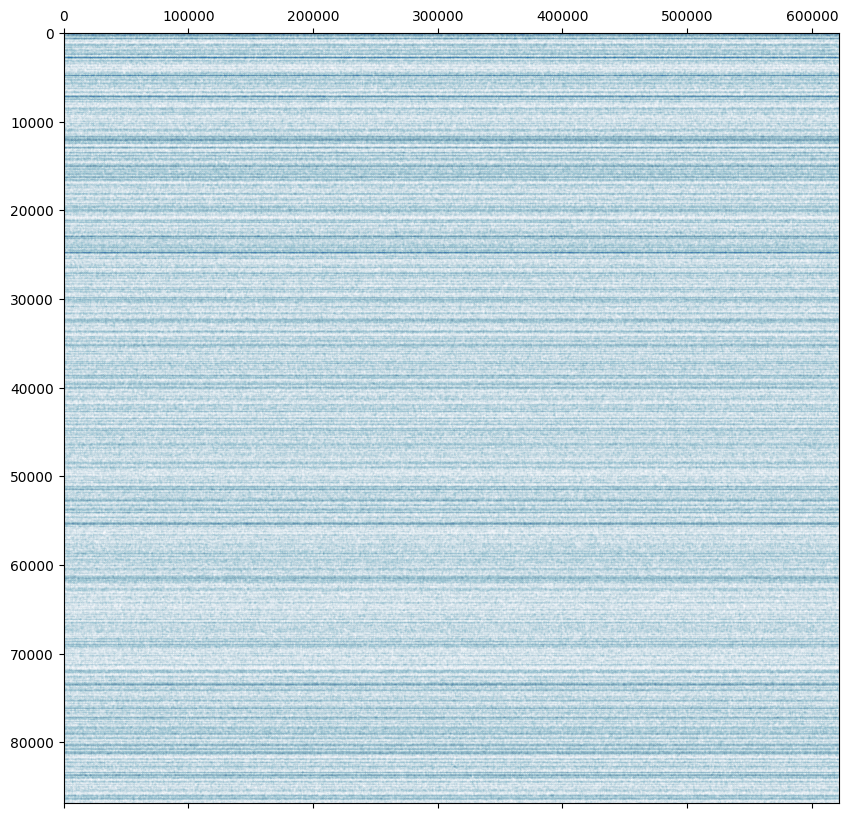
Exploring Term-Document Matrix
This is part of a project on extracting word representations using statistical language modeling techniques. This part includes rudimentary corpus preprocessing, tokenization, vectorization, and inferences within the vector space model. The corpus is a public domain dataset of a million news headlines from the Australian Broadcasting Corporation between 2003 and 2021.
All code blocks for this part of the project are included in this document. The first block includes the imports used in this part of the project.
https://github.com/Using-Namespace-System/FeatureSpace.git
The Whole project can be cloned from the link above into a dev container and the configs will include the necessary dependencies.
from itertools import zip_longest
from matplotlib.pyplot import figure
import nltk
from nltk.corpus import stopwords
import numpy as np
import pandas as pd
from scipy.sparse import csr_array
from scipy.sparse import find
from pickleshare import PickleShareDB
df = pd.read_csv('../input/abcnews-date-text.csv')
nltk.download('stopwords')
stopwords_set = set(stopwords.words('english'))
Preprocessing the corpus is simplified to filtering out short headlines, small words, and stop-words. Each action is completed in pandas, I believe this may improve readability. The documents are exploded into a single series representing the whole corpus. From here stop-words can be filtered out. No further sanitation is performed.
#tokenize and sanitize
#tokenize documents into individual words
df['tokenized'] = df.headline_text.str.split(' ')
#remove short documents from corpus
df['length'] = df.tokenized.map(len)
df = df.loc[df.length > 1]
#use random subset of corpus
df=df.sample(frac=0.50).reset_index(drop=True)
#flatten all words into single series
ex = df.explode('tokenized')
#remove shorter words
ex = ex.loc[ex.tokenized.str.len() > 2]
#remove stop-words
ex = ex.loc[~ex.tokenized.isin(stopwords_set)]
#create dictionary of words
#shuffle for sparse matrix visual
dictionary = ex.tokenized.drop_duplicates().sample(frac=1)
#dataframe with (index/code):word
dictionary = pd.Series(dictionary.tolist(), name='words').to_frame()
#store code:word dictionary for reverse encoding
dictionary_lookup = dictionary.to_dict()['words']
#offset index to prevent clash with zero fill
dictionary['encode'] = dictionary.index + 1
#store word:code dictionary for encoding
dictionary = dictionary.set_index('words').to_dict()['encode']
#use dictionary to encode each word to integer representation
encode = ex.tokenized.map(dictionary.get).to_frame()
encode.index.astype('int')
encode.tokenized.astype('int')
#un-flatten encoded words back into original documents
docs = encode.tokenized.groupby(level=0).agg(tuple)
#match up document indexes for reverse lookup
df = df.sort_index().iloc[docs.index].reset_index(drop=True)
docs = docs.reset_index()['tokenized']
In this instance the word vector is a count vector. This is similar to one-hot but is able to convey how many times the term occurred in the document.
For the news headline dataset, document-wise term repetition is minimal and the statistical weight it provides is negligible.
#zero pad x dimension by longest sentence
encoded_docs = list(zip(*zip_longest(*docs.to_list(), fillvalue=0)))
#convert to sparse matrix
encoded_docs = csr_array(encoded_docs, dtype=int)
#convert to index for each word
row_column_code = find(encoded_docs)
#presort by words
word_sorted_index = row_column_code[2].argsort()
doc_word = np.array([row_column_code[0][word_sorted_index], row_column_code[2][word_sorted_index]])
#presort by docs and words
doc_word_sorted_index = doc_word[0].argsort()
doc_word = pd.DataFrame(np.array([doc_word[0][doc_word_sorted_index], doc_word[1][doc_word_sorted_index]]).T, columns=['doc','word'])
#offset code no longer needed after zero-fill
doc_word.word = doc_word.word - 1
#convert to index of word counts per document
doc_word_count = doc_word.groupby(['doc','word']).size().to_frame('count').reset_index().to_numpy().T
#convert to sparse matrix
sparse_word_doc_matrix = csr_array((doc_word_count[2],(doc_word_count[0],doc_word_count[1])), shape=(np.size(encoded_docs, 0),len(dictionary)), dtype=float).T
#visualize sparse matrix
fig = figure(figsize=(10,10))
sparse_word_doc_matrix_visualization = fig.add_subplot(1,1,1)
sparse_word_doc_matrix_visualization.spy(sparse_word_doc_matrix, markersize=0.007, aspect = 'auto')
%store sparse_word_doc_matrix
%store dictionary
%store dictionary_lookup
Out[ ]:

The words that occur together often in the corpus also, as word vectors, are closer together in this 600000 dimensional vector space. This is demonstrated in the table below.
In [ ]:
#approximating cosine similarity with dot product of the term document matrix and its transform
similarity_matrix = sparse_word_doc_matrix @ sparse_word_doc_matrix.T
#displaying slice of matrix with highest similarity scores
similarity_matrix_compressed = similarity_matrix[(-similarity_matrix.sum(axis = 1)).argsort()[:6]].toarray()
pd.DataFrame((-similarity_matrix_compressed).argsort(axis = 1)[:6,:6].T).applymap(dictionary_lookup.get)
| 0 | 1 | 2 | 3 | 4 | 5 | |
|---|---|---|---|---|---|---|
| 0 | police | new | man | says | court | nsw |
| 1 | man | zealand | charged | govt | man | rural |
| 2 | investigate | laws | police | minister | accused | police |
| 3 | probe | police | court | australia | face | govt |
| 4 | missing | cases | murder | new | told | country |
| 5 | search | york | jailed | trump | faces | coast |
Similarly, the documents with the most similarities are closer together in the vector space.
#previewing document similarity
doc_similarity_matrix = sparse_word_doc_matrix.T @ sparse_word_doc_matrix
#displaying slice of matrix with highest similarity scores
doc_similarity_matrix_compressed = doc_similarity_matrix[(-doc_similarity_matrix.sum(axis = 1)).argsort()[:6]].toarray()
pd.DataFrame((-doc_similarity_matrix_compressed).argsort(axis = 1)[:6,:6].T).applymap(df.headline_text.to_dict().get)
| 0 | 1 | 2 | 3 | 4 | 5 | |
|---|---|---|---|---|---|---|
| 0 | man bites police officer on new years day in a... | police search for man over police van crash | police search for man 'involved in police chas... | police union backs new police leadership team | new south wales government setting up new poli... | police investigate report of man impersonating... |
| 1 | new half day public holidays on christmas eve ... | police search for man 'involved in police chas... | police search for man over police van crash | police union demands answers over appointment ... | new south wales records 1485 new cases of covi... | police charge man for impersonating officer |
| 2 | istanbul police arrest new years day gunman and | police search for police assault suspect | police search for man over fatal sydney stabbing | police union slams police commissioner for cho... | new south wales covid coronavirus five new loc... | queensland police describe man police believe |
| 3 | police make new years day drink driving arrests | police investigate report of man impersonating... | police investigate report of man impersonating... | nt police urge examination of new police numbers | new president for new south wales farmers | man charged with impersonating police officer |
| 4 | new police information about tasmanian man mis... | queensland police describe man police believe | police to search sydney creek for missing man | wa police union president harry arnott stood a... | a new dairy body in new south wales has received | police search for man 'involved in police chas... |
| 5 | brother of man fatally stabbed on new years da... | police investigation after man struck by polic... | queensland police describe man police believe | wa police commissioner backs down on new polic... | new south wales retains top ranking in new two... | man charge with impersonating police officer a... |

